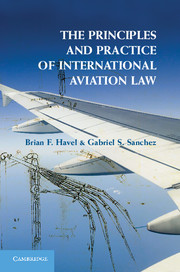Book contents
- Frontmatter
- Contents
- Preface
- Acknowledgments
- Table of Abbreviations and Acronyms
- 1 What is International Aviation Law?
- 2 The Foundations of Public International Aviation Law
- 3 The International Law Regime for Trade in Air Services
- 4 The International Law Regime for Airline Investment and Global Alliances
- 5 The International Law Regime for Aviation Safety and Security
- 6 The International Law Regime for Aviation and the Environment
- 7 The International Law Regime for Air Carrier Liability and Surface Damage
- 8 The International Law Regime for Aircraft Financing and Aircraft Nationality
- Afterword
- Select Bibliography
- Table of Authorities
- Index
- References
5 - The International Law Regime for Aviation Safety and Security
Published online by Cambridge University Press: 05 June 2014
- Frontmatter
- Contents
- Preface
- Acknowledgments
- Table of Abbreviations and Acronyms
- 1 What is International Aviation Law?
- 2 The Foundations of Public International Aviation Law
- 3 The International Law Regime for Trade in Air Services
- 4 The International Law Regime for Airline Investment and Global Alliances
- 5 The International Law Regime for Aviation Safety and Security
- 6 The International Law Regime for Aviation and the Environment
- 7 The International Law Regime for Air Carrier Liability and Surface Damage
- 8 The International Law Regime for Aircraft Financing and Aircraft Nationality
- Afterword
- Select Bibliography
- Table of Authorities
- Index
- References
Summary
A Collaborative Process of Ensuring Aviation Safety
Since its inception, aviation has imbued the public mind with feelings of awe accompanied by outsized fears regarding its associated dangers. In response to these latter concerns, State and industry actors have made safety, and, in later years, security, a primary concern of global regulatory efforts. States have surrendered their sovereign authority over the subject of safety regulation to an extent far greater than has been done with regard to any other topic in this book. Although States have remained individually responsible for certifying the airworthiness of aircraft, for licensing pilots and other crewmembers, and for implementing the technical procedures and practices that the ICAO declares necessary to achieve an acceptable level of safety, for most of the world’s States these activities have meant adhering to standards originating elsewhere. The institutional and legal framework for international civil aviation safety regulation, in fact, is more collaborative and less controversial, more ICAO-driven and less reliant on State-to-State negotiations and bilateral agreements, than any topic we have covered thus far. Owing in part to its quiet, steady development and in part to its highly technical nature, safety regulation tends to receive less scholarly attention than other areas of aviation law and policy, and the concise treatment with which we begin this chapter reflects that reality. But conciseness of treatment should in no way be considered a reflection on the subject’s importance or on its place within the spectrum of issues commanding the attention of State and industry actors.
- Type
- Chapter
- Information
- The Principles and Practice of International Aviation Law , pp. 173 - 216Publisher: Cambridge University PressPrint publication year: 2014
References
- 1
- Cited by



